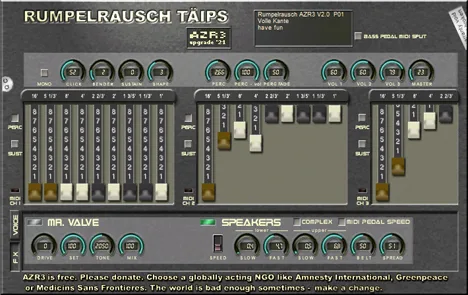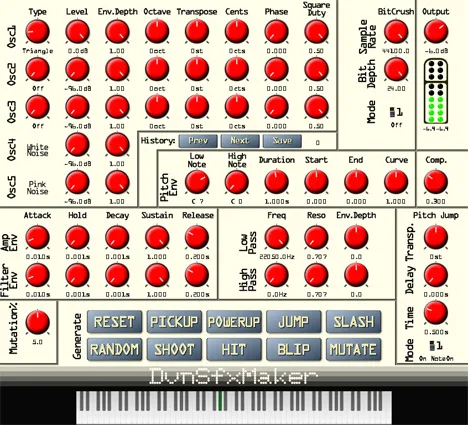AZR-3: A Virtual Organ with Character from Rumpelrausch
In the world of music production and performance, the search for the perfect instrument sound is a constant endeavor. For keyboardists, producers, and composers striving to recreate the rich, live sound of drawbar organs, such as the classic Hammond, virtual instruments become an indispensable tool. AZR-3 from developer Rumpelrausch is such an instrument, offering a fresh perspective on organ emulation, providing musicians with flexibility and unique creative possibilities.
What is AZR-3?
AZR-3 is a virtual instrument in VST format, specifically designed for emulating a drawbar organ. This plugin allows you to obtain the characteristic sound that has defined jazz, blues, rock, gospel, and many other genres for decades. It imitates the classic organ structure with two manuals (keyboards) and a pedal section, providing full control over all the main components of sound generation.
While AZR-3 doesn’t aim to be a 100% emulation of a specific tone wheel organ model with all its nuances and artifacts, it offers its own unique character. One of the key differences is the ability to choose different basic waveforms in addition to the standard sine waves, which are the foundation of classic tone wheel organs. This feature opens up new horizons for sound design, allowing you to create timbres that go beyond the traditional organ sound, adding texture, richness, and experimental shades. This makes AZR-3 a versatile instrument not only for reproducing classic parts but also for use in modern genres where an unusual but recognizable organ “grain” is needed.
Key Features and Functionality
AZR-3 is equipped with a set of functions that allow you to deeply control and shape the sound, bringing it closer to the feeling of playing a real organ:
- Drawbar Control: A complete set of drawbars for each manual and pedal section allows you to precisely adjust the harmonic ratios, creating an endless palette of timbres – from soft and airy to dense and aggressive.
- Click Emulation: Adds the characteristic clicks when pressing and releasing keys, which are an integral part of the sound of many vintage organs and add realism and “dirt” to the sound.
- Sustain: The sustain function allows you to hold notes, which is useful for creating long chords or melodic lines.
- Percussion: Imitates a percussive attack, which adds a short, ringing transient at the beginning of the note, characteristic of many classic organs. This can be either soft or a more expressive “bell”.
- Pitch Bend: The ability to use pitch bend to introduce expression into melodic parts, allowing you to “bend” notes or create vibrato manually.
- Vibrato: The built-in vibrato effect adds a characteristic pitch tremor, making the sound more lively and rich.
- Distortion / Overdrive: A built-in effect for adding warmth, density, or aggressive overload to the organ sound, which is an important element in rock and blues music.
- Rotating Speakers Emulation: No organ sound will be complete without the Leslie effect. AZR-3 includes a high-quality emulation of rotating speakers, which creates the signature “pulsating” and spatial sound that can be heard on many classic recordings. Speed control (slow/fast) allows you to accurately reproduce the dynamics of a real acoustic system.
Who is AZR-3 for?
AZR-3 will be a great addition to the arsenal of any musician or producer looking for a high-quality virtual organ. It is ideal for:
- Keyboardists who want to have an authentic organ sound in their digital audio workstation (DAW).
- Musicians who play jazz, blues, funk, soul, rock, gospel, and other genres where the organ plays a significant role.
- Producers looking for unique timbres for their tracks, going beyond standard presets.
- Composers for creating music for films, games, or theatrical productions.
Due to its flexibility and set of features, AZR-3 is a powerful tool for both studio work and live performances.
Technical Details and Compatibility
The AZR-3 plugin is available in VST format, which provides wide compatibility with most popular DAWs on the Windows platform (both 32-bit and 64-bit systems). Developer Rumpelrausch offers this instrument, making it accessible to a wide range of users.
Installing the plugin is standard for VST instruments and usually involves placing the files in the appropriate VST plugin directory of your DAW.
Conclusion
AZR-3 from Rumpelrausch is more than just another organ emulation. It is an instrument with its own character, which, thanks to the ability to choose basic waveforms and a full set of classic organ functions, offers significant flexibility. From classic jazz passages to aggressive rock riffs with overdrive and cosmic textures – AZR-3 is ready for any experiments. If you are looking for a virtual organ that combines authentic drawbar control capabilities with modern features and unique sound design options, AZR-3 deserves your attention.
Try AZR-3 to add the warmth, richness, and unique character of a drawbar organ to your music.



